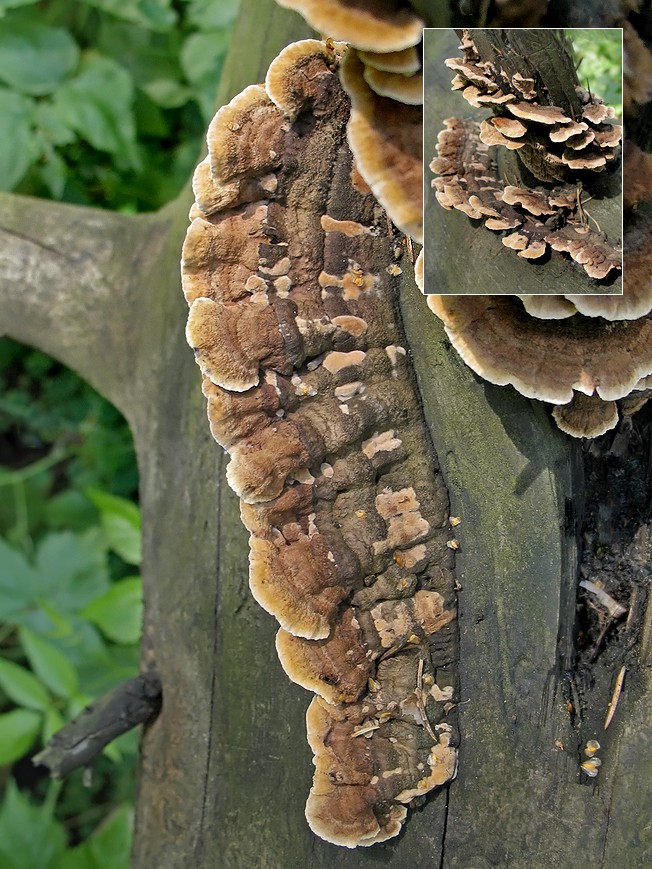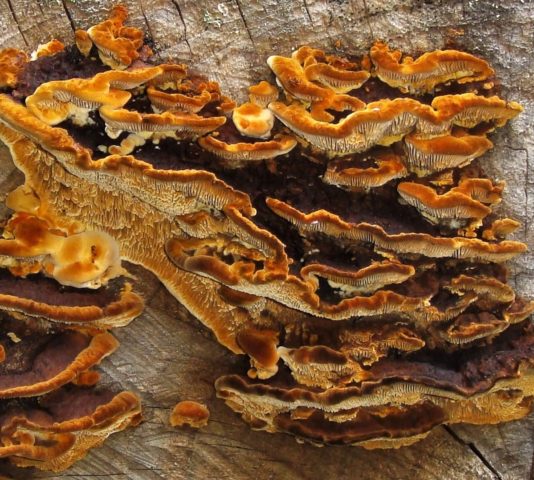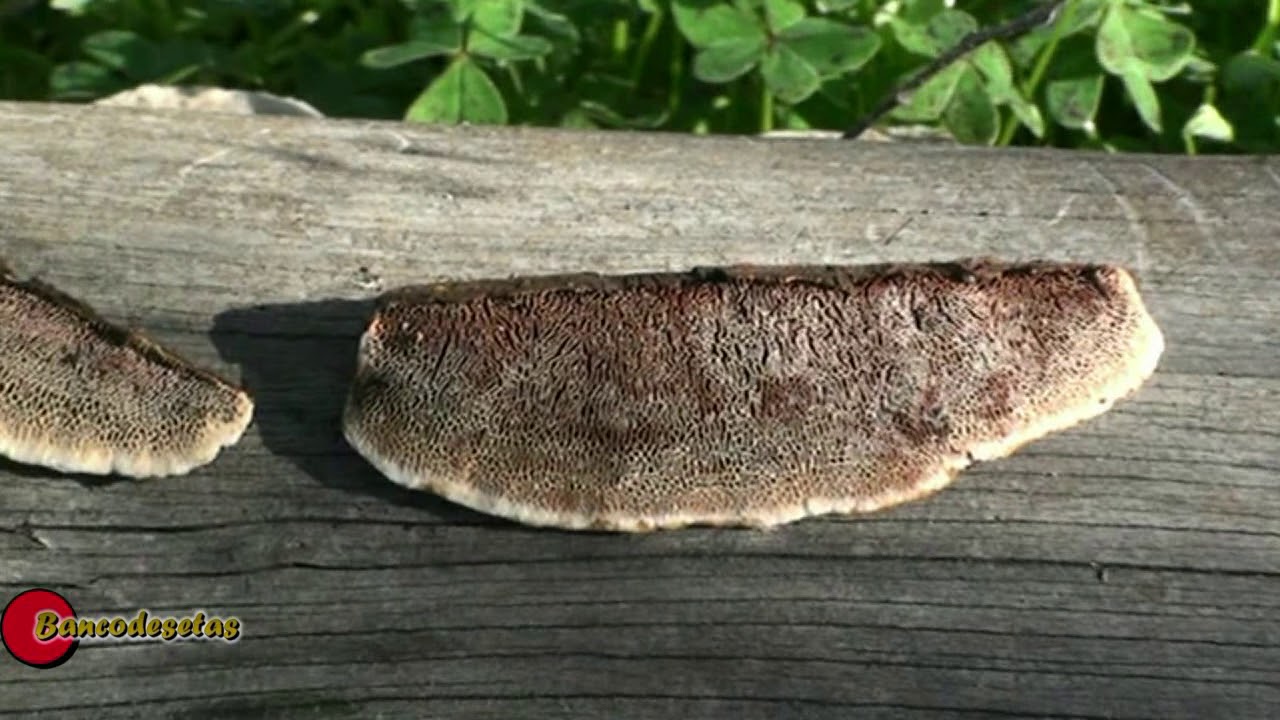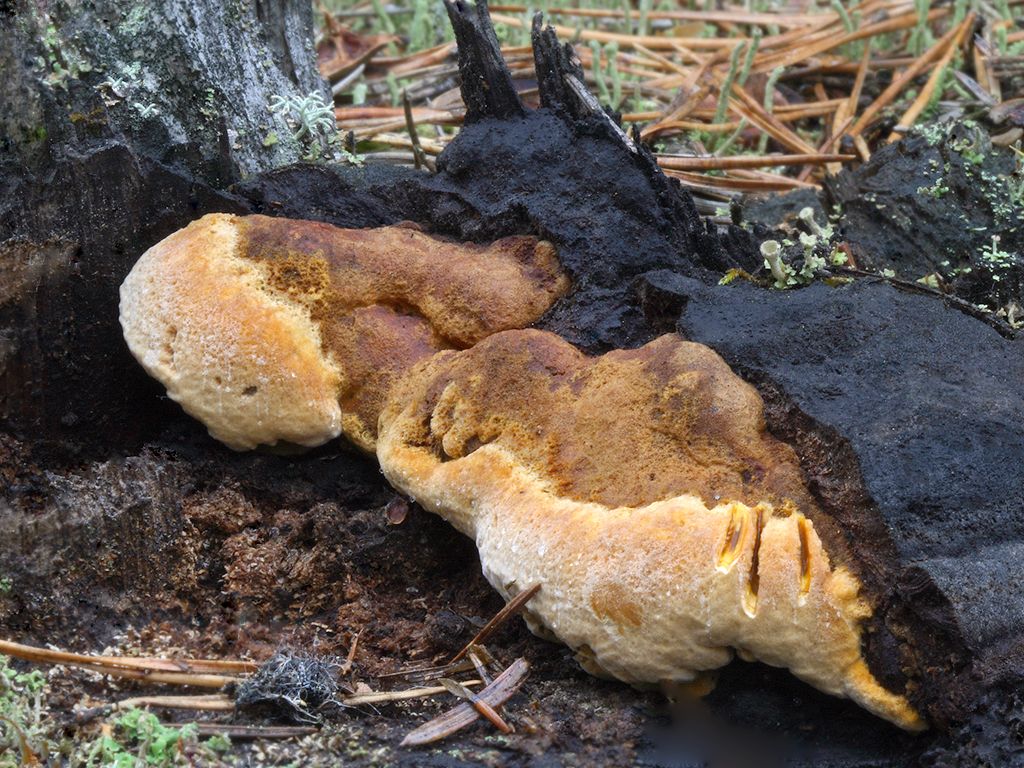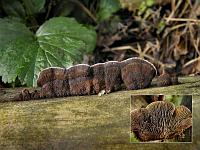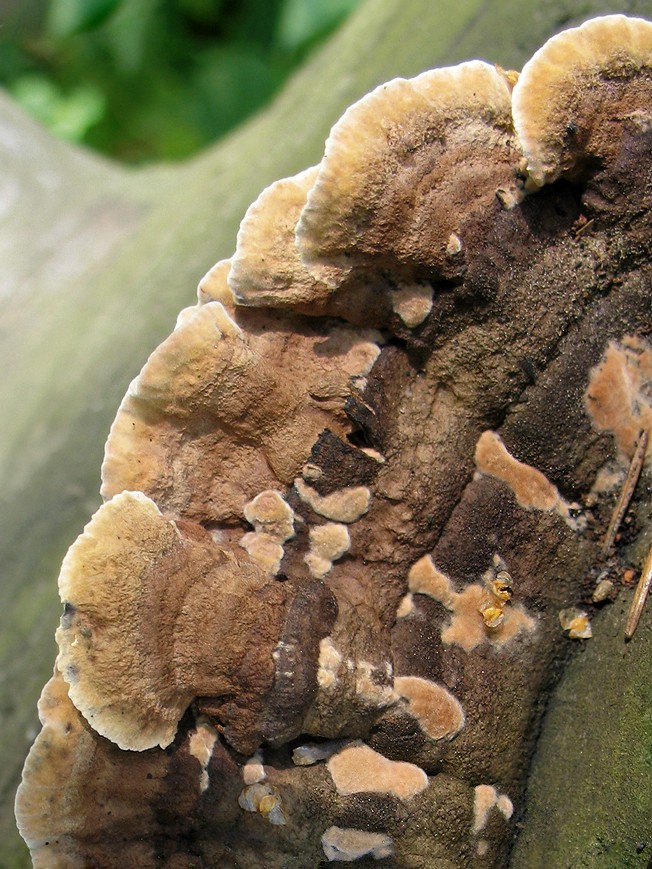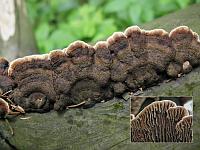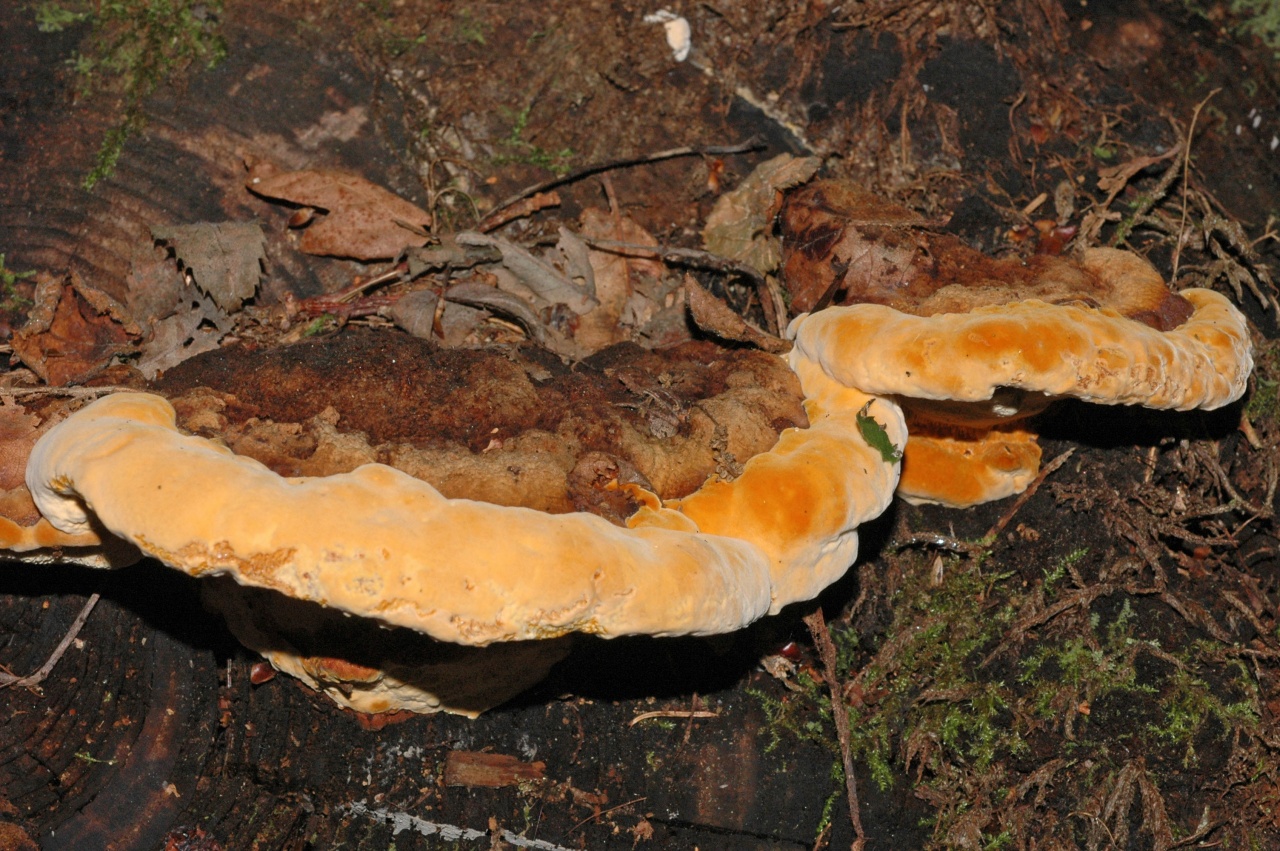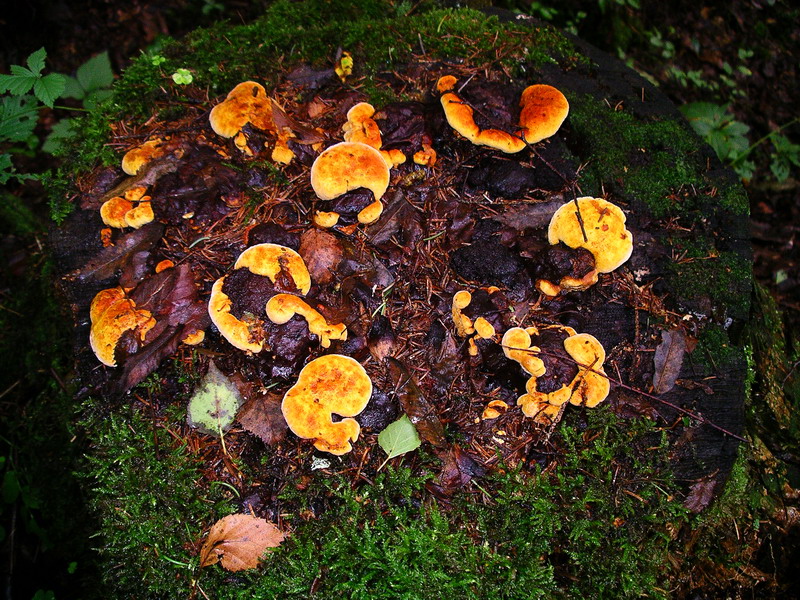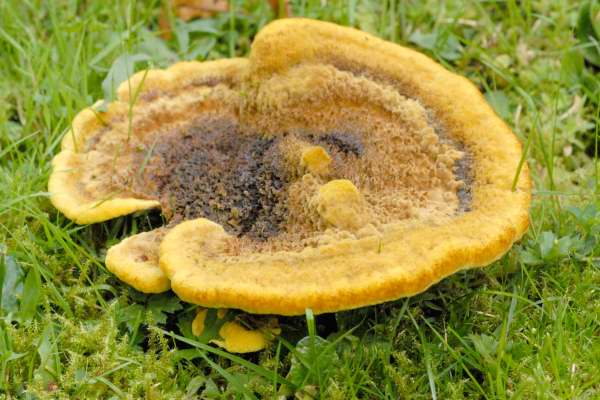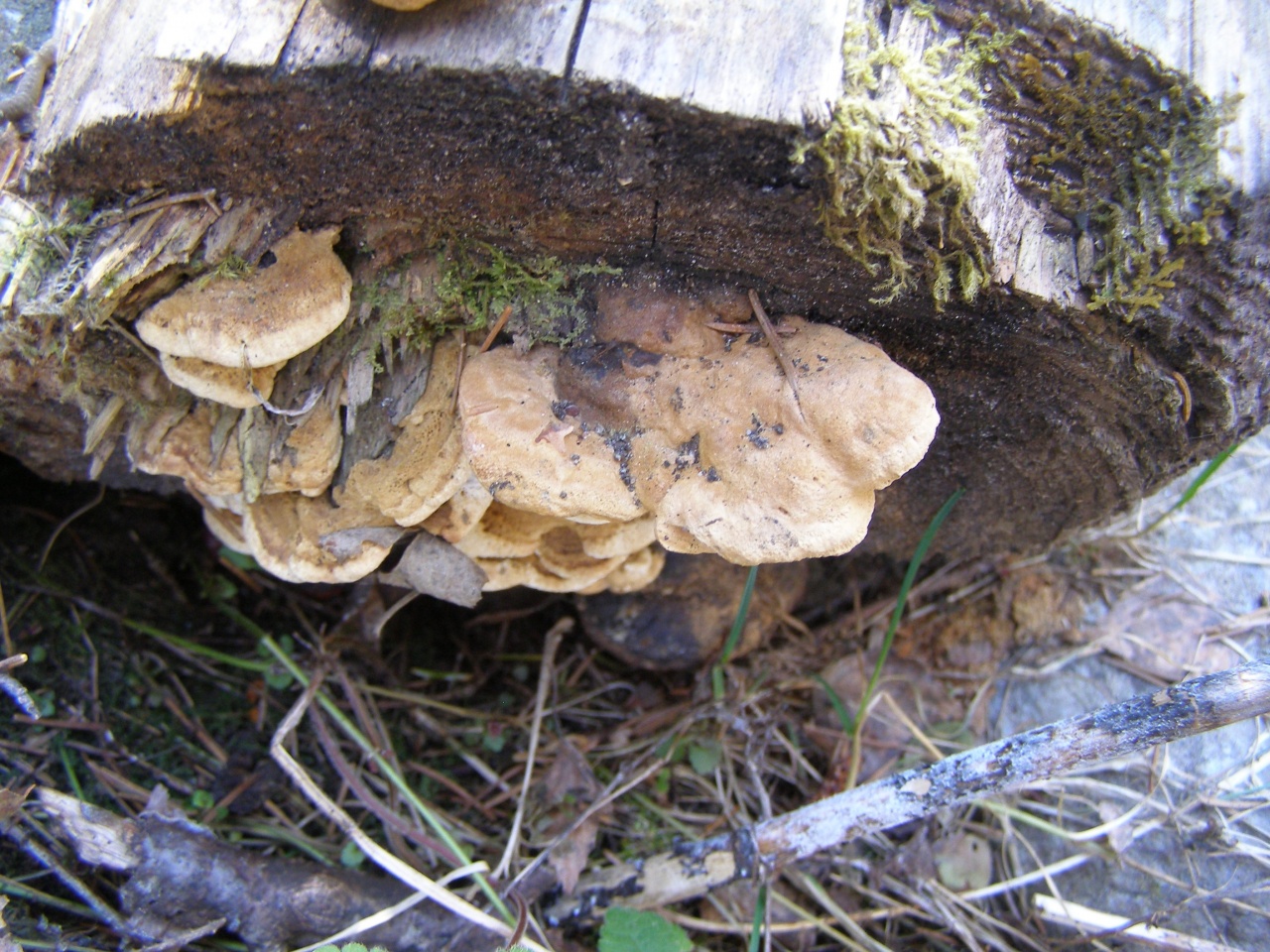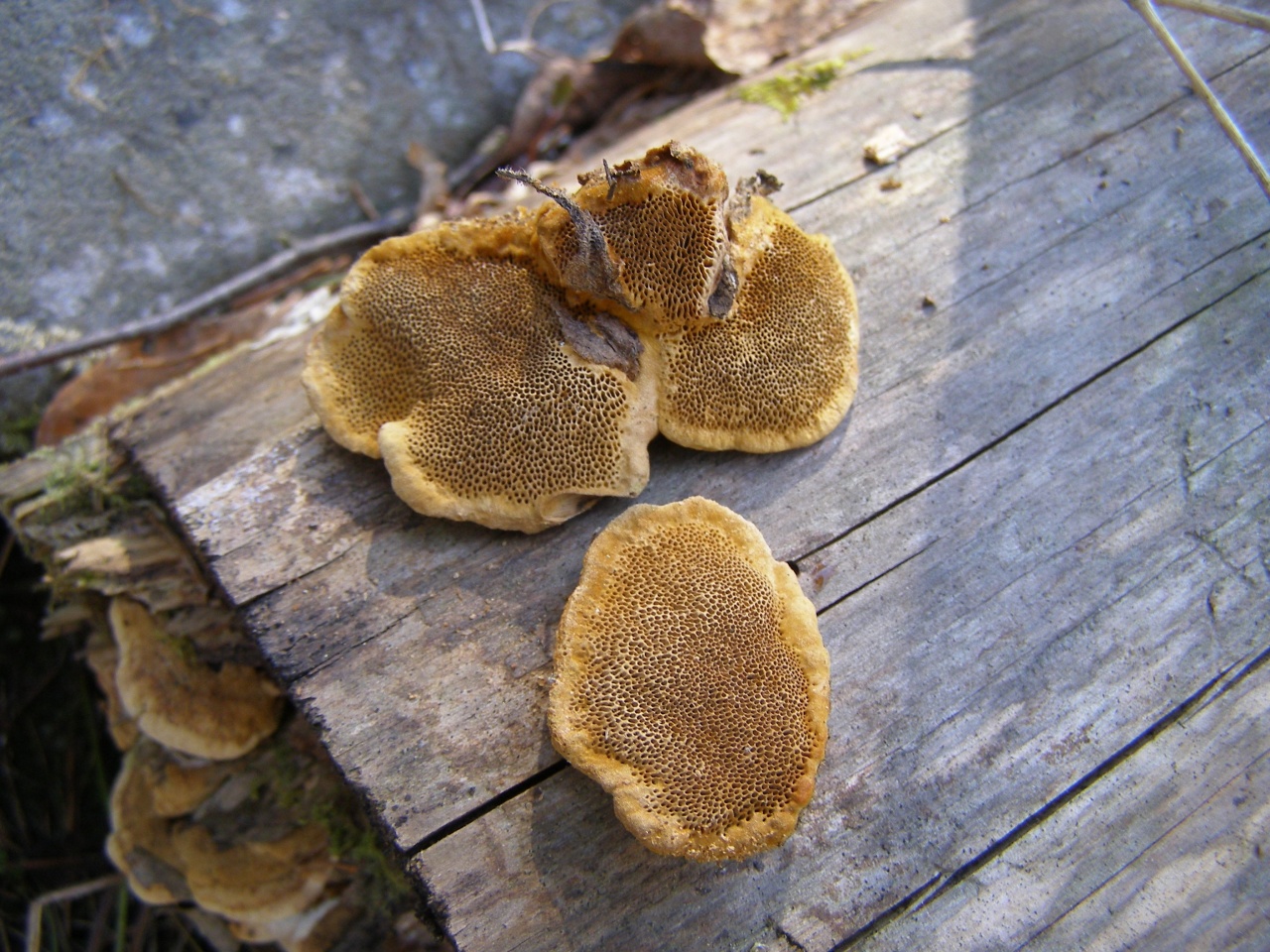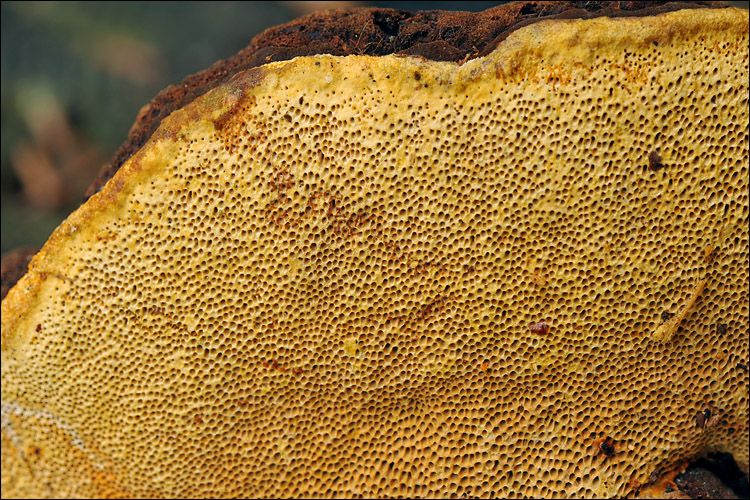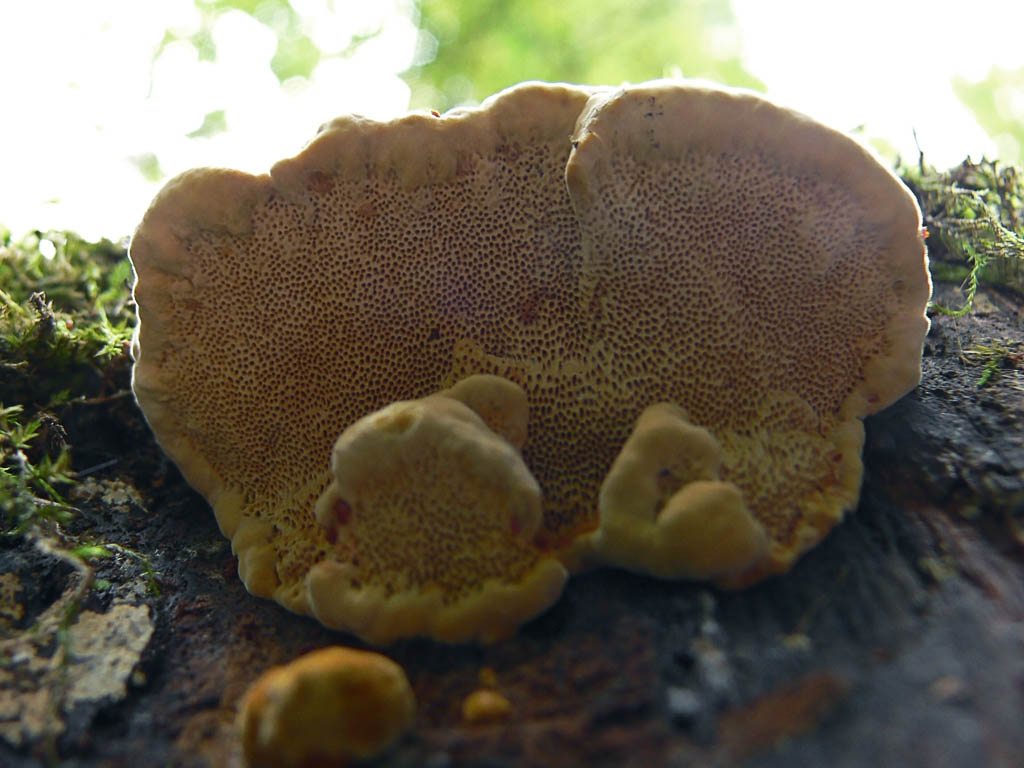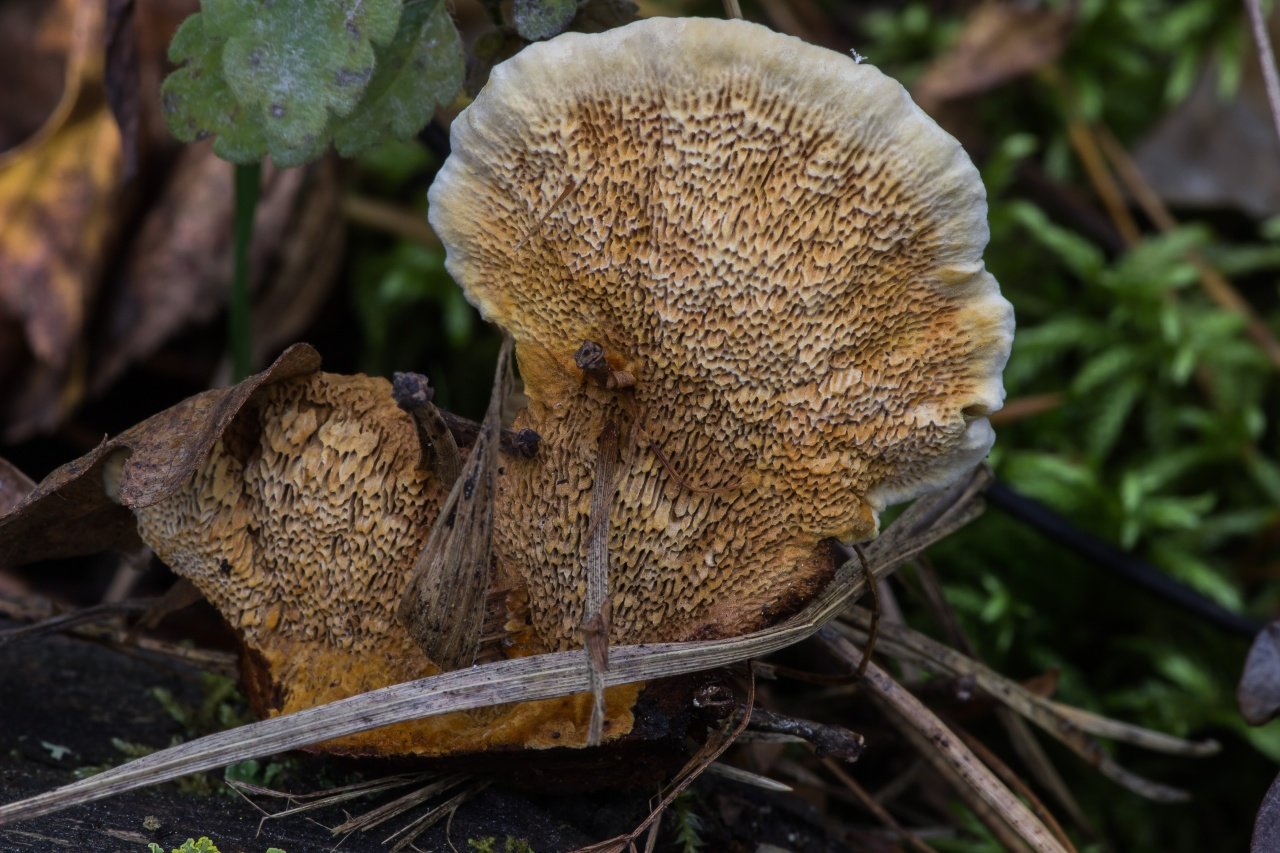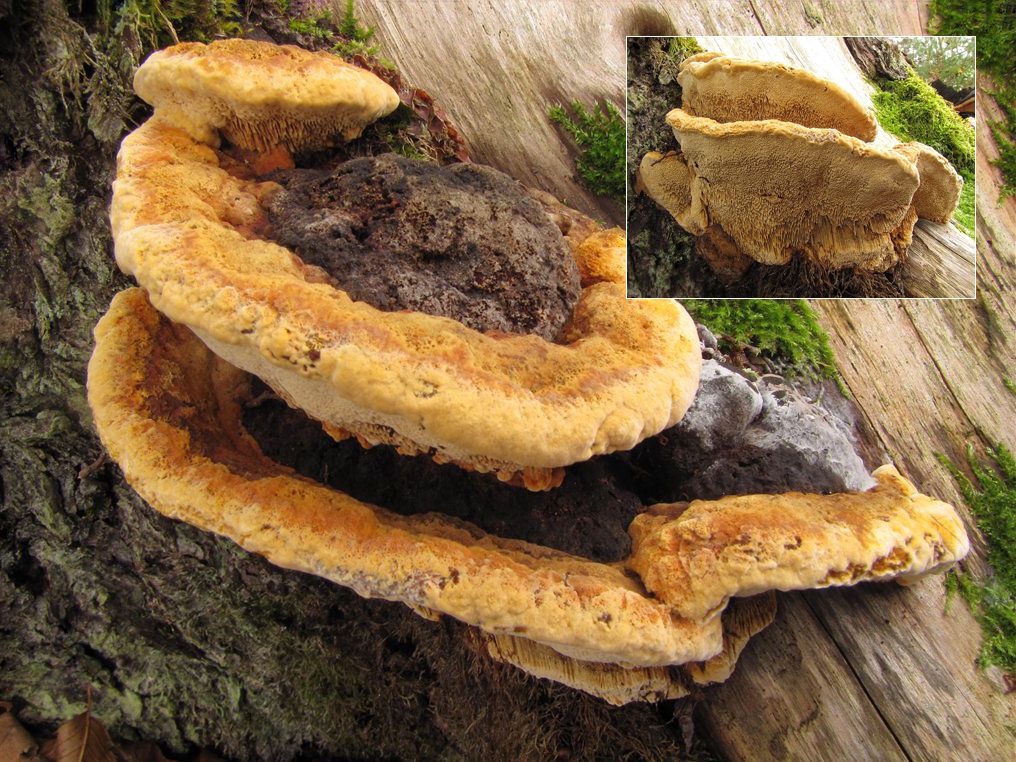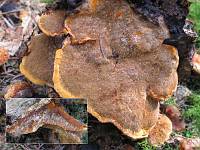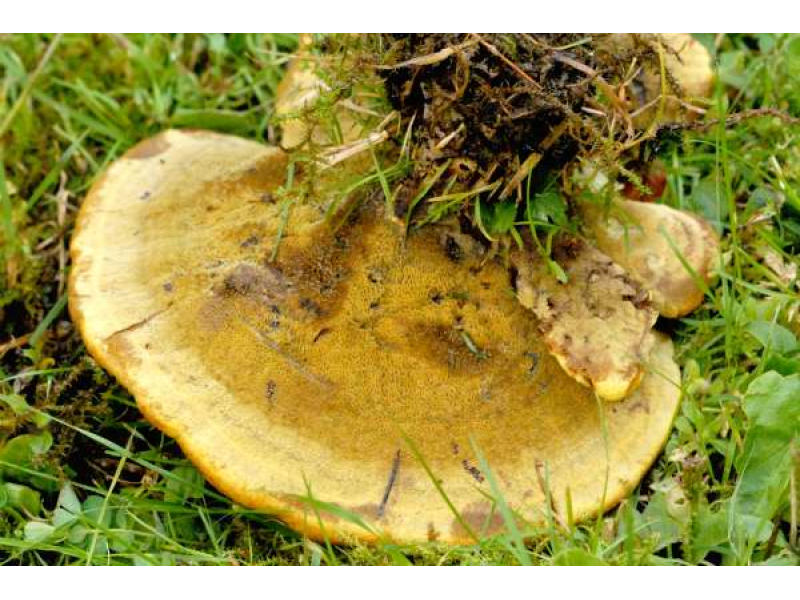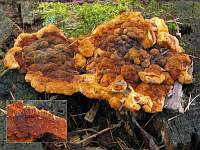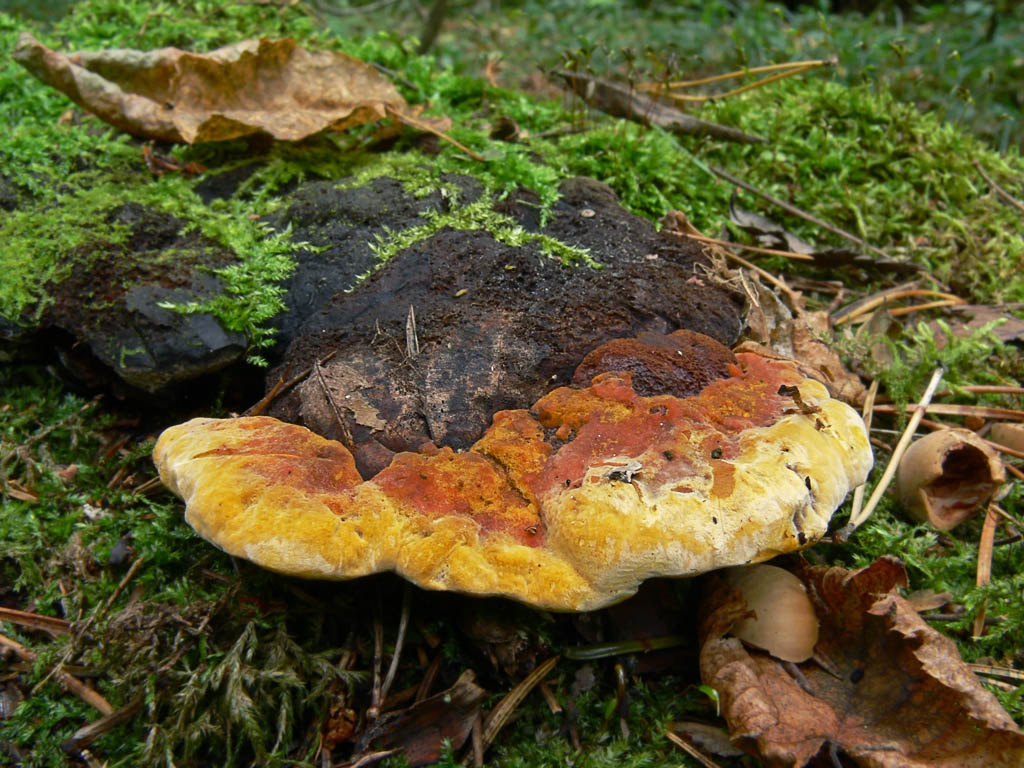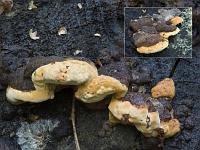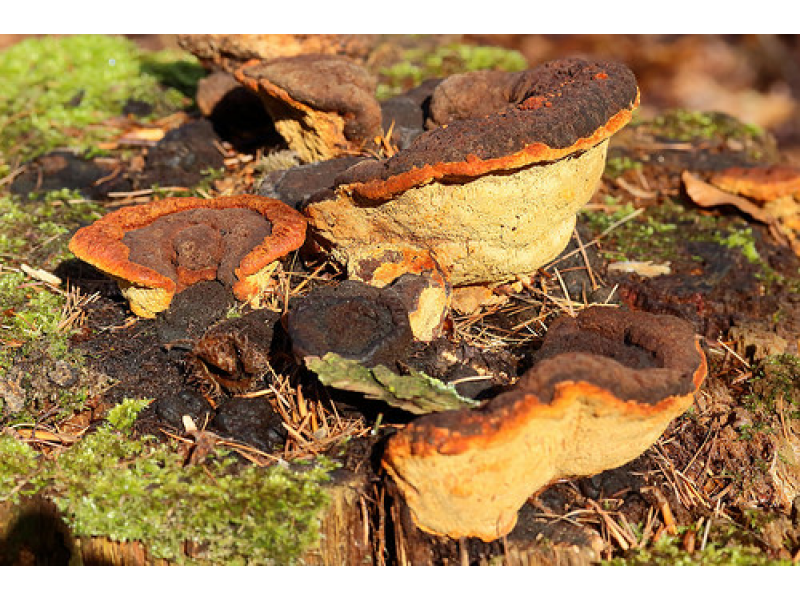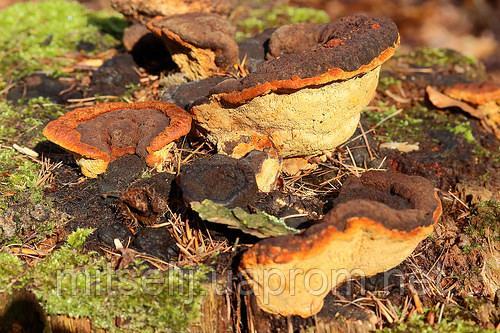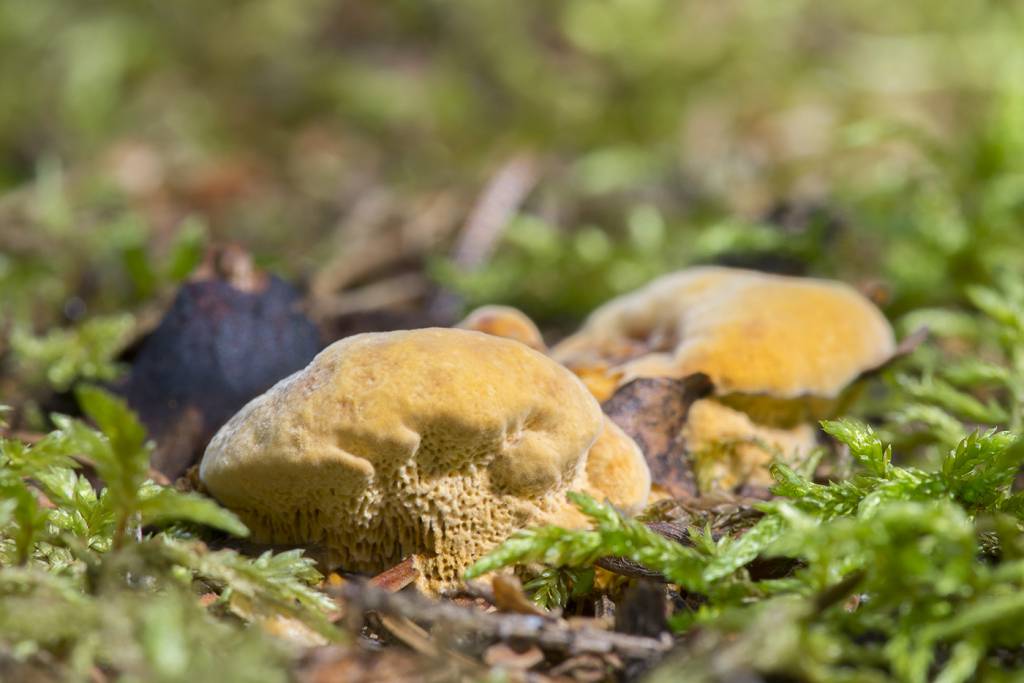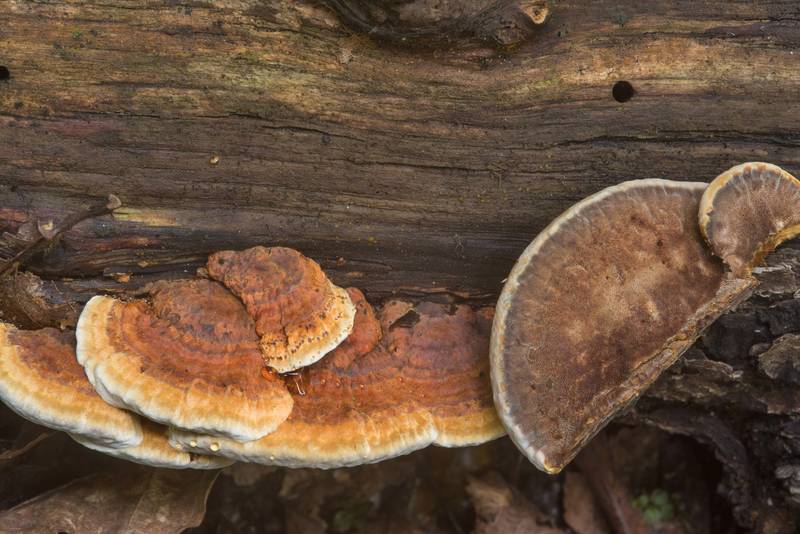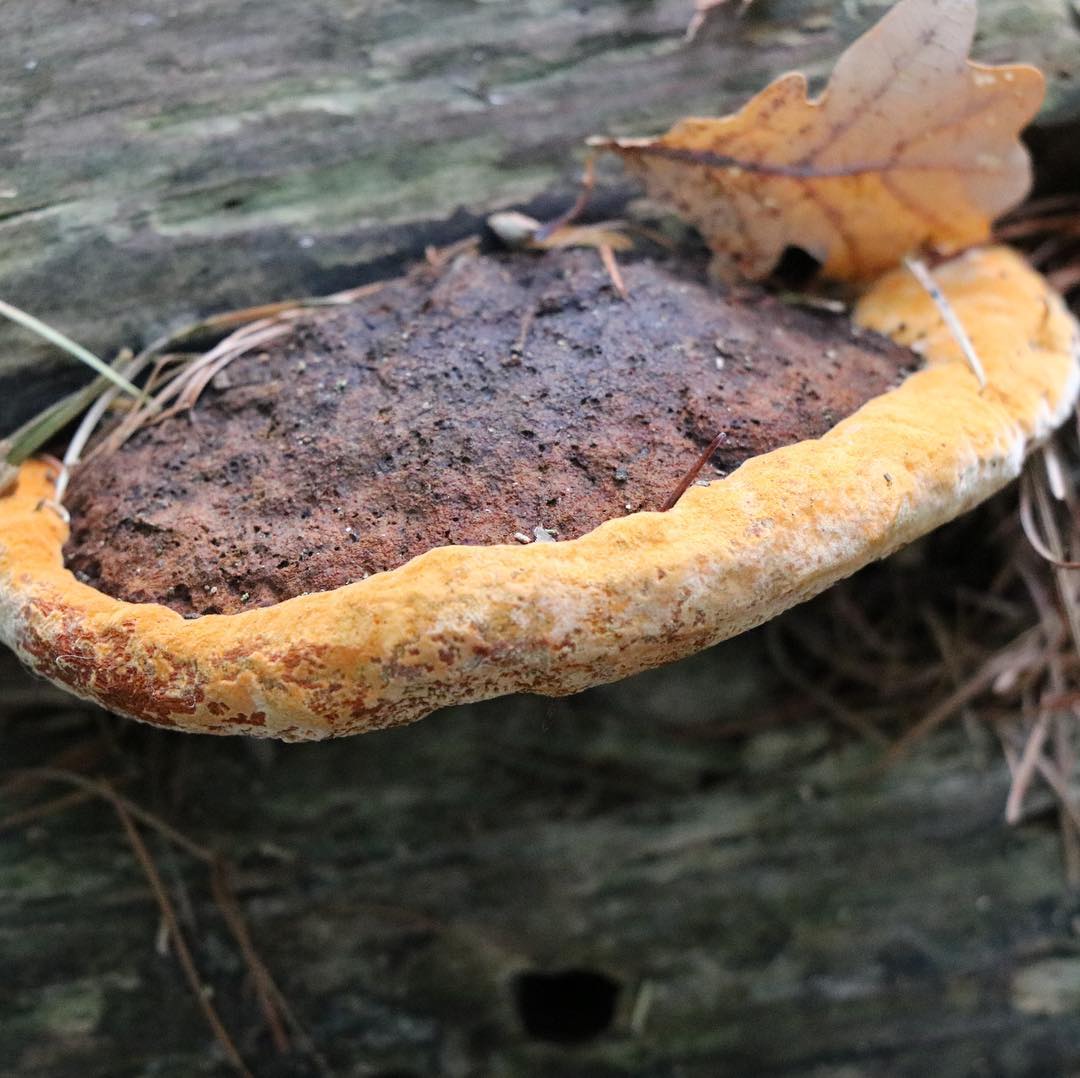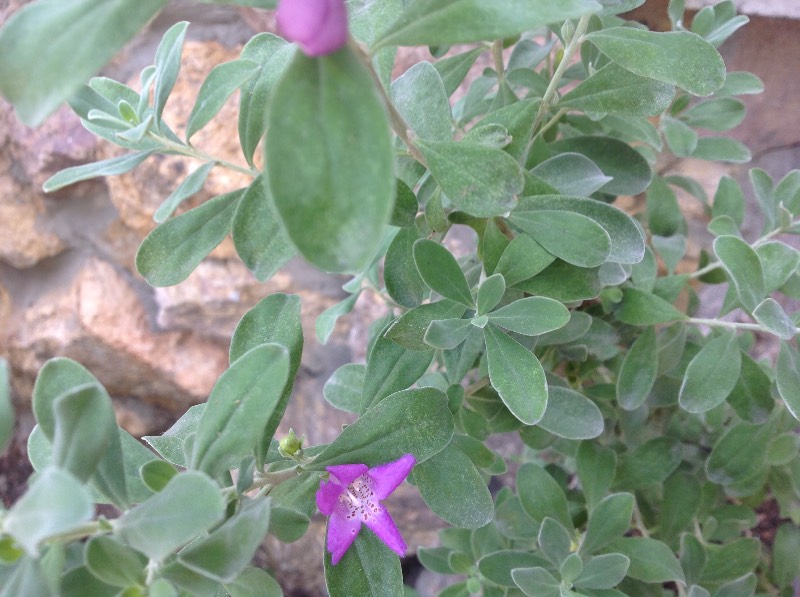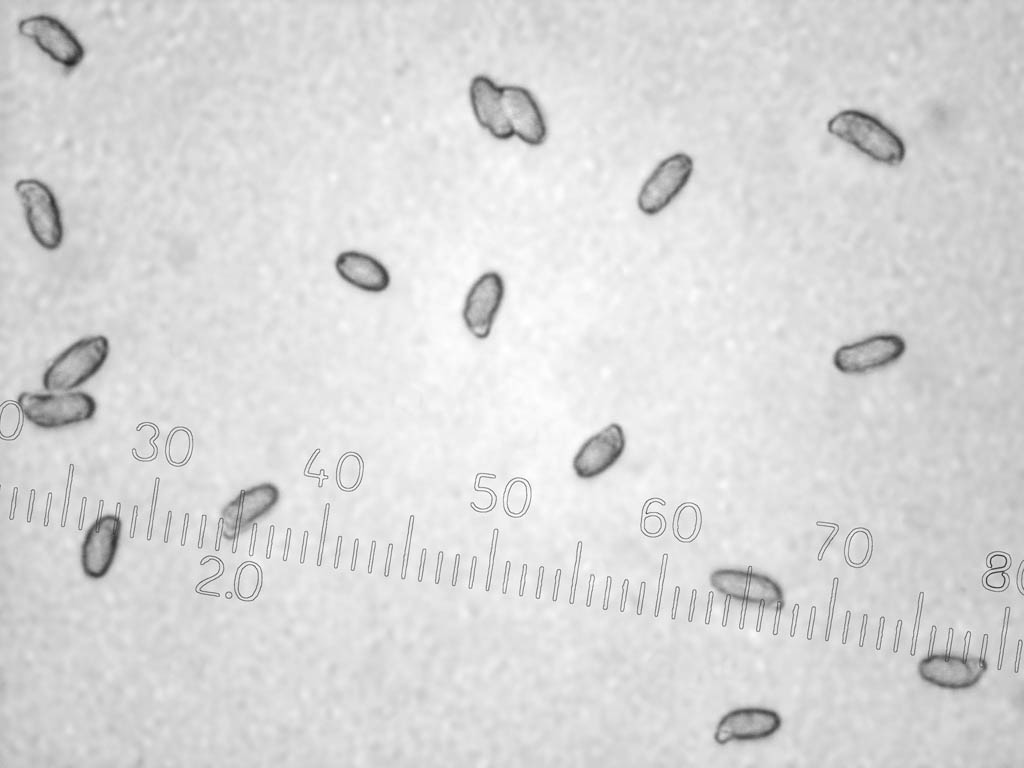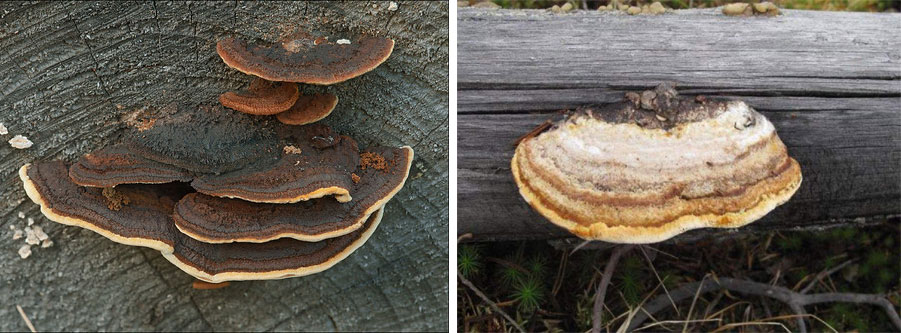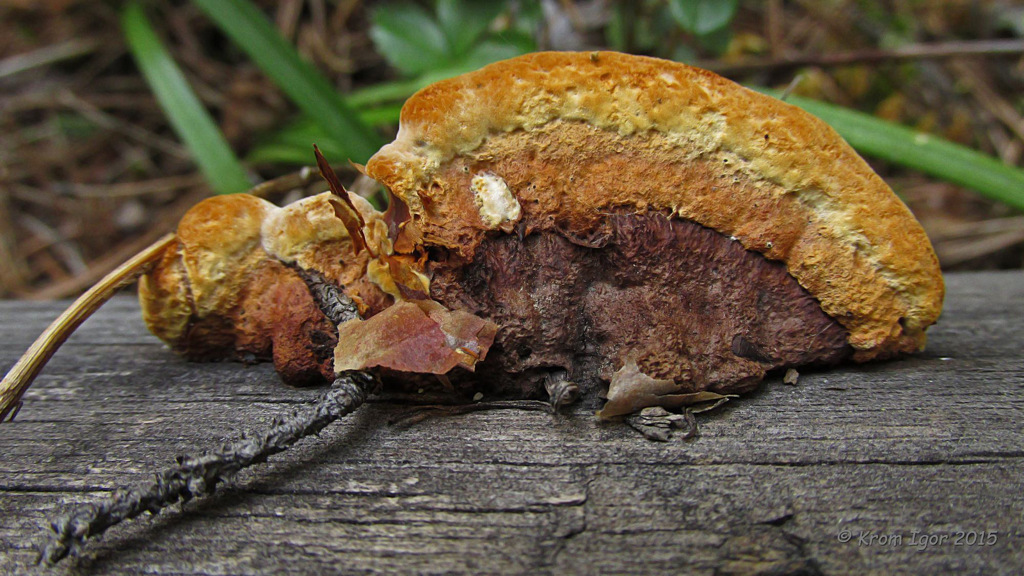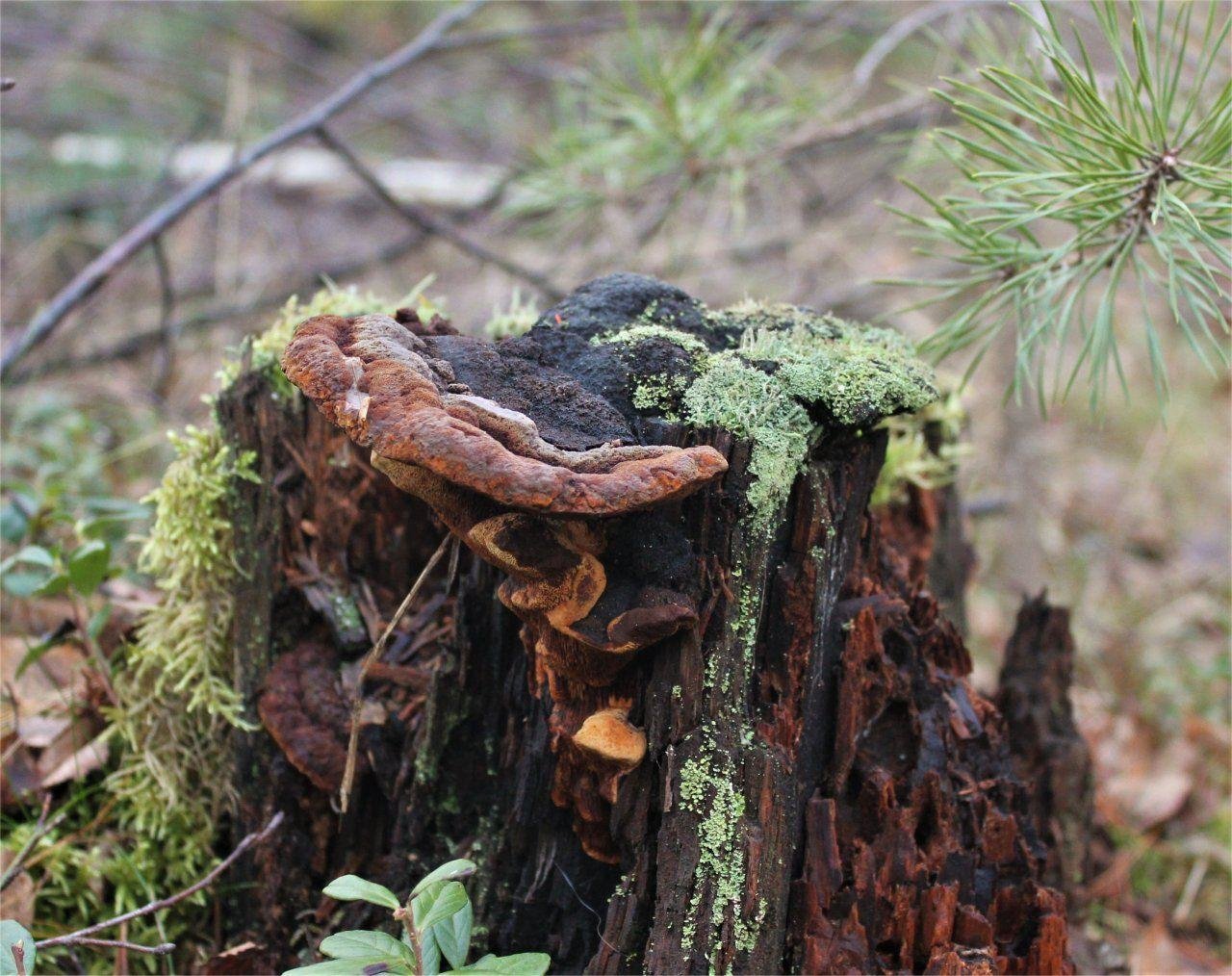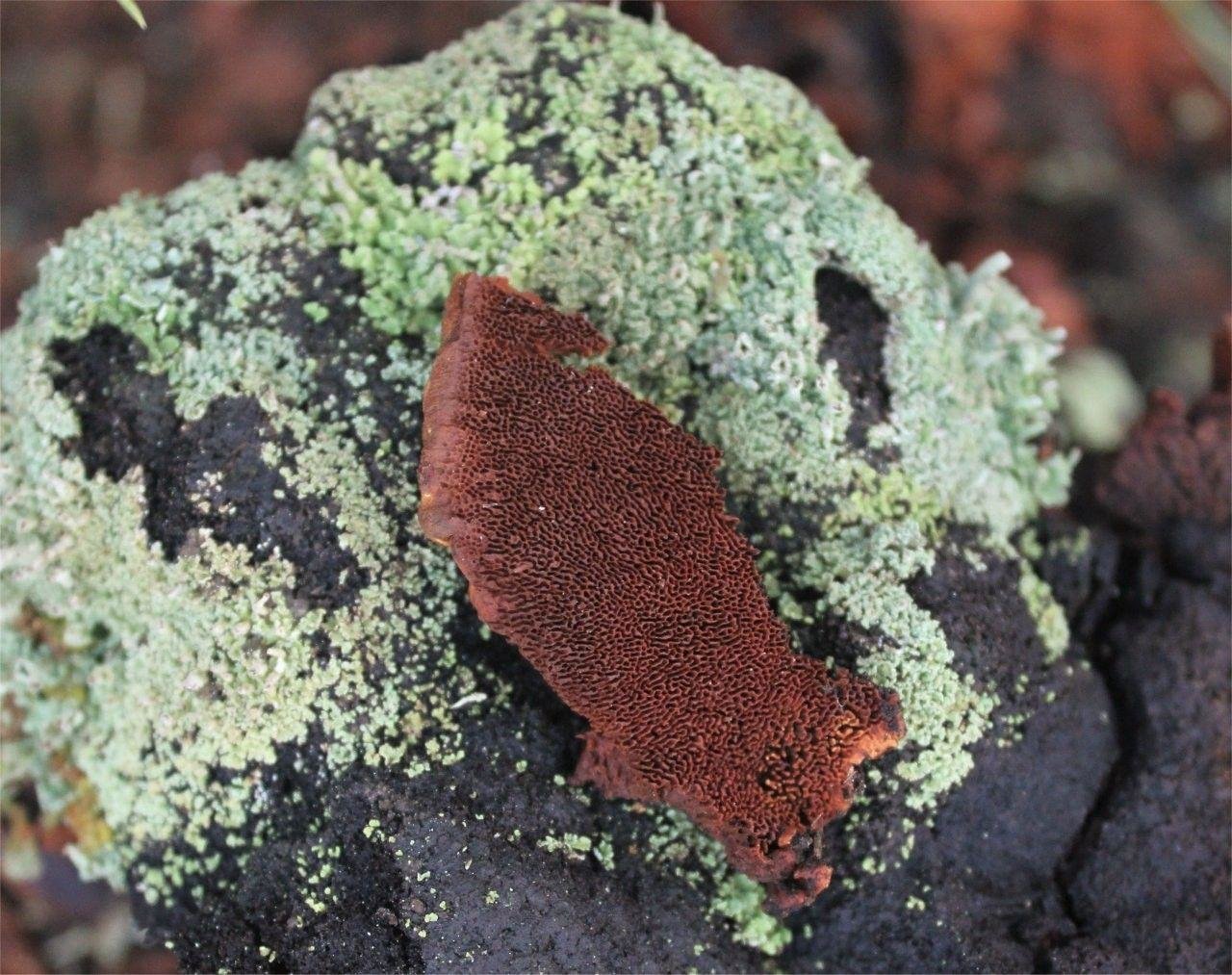Gleophyllum odorous: photo and description
| Name: | Gleophyllum odorous |
| Latin name: | Gloeophyllum odoratum |
| Type of: | Inedible |
| Specifications: | |
| Systematics: |
|
Fragrant Gleophyllum is a perennial mushroom that belongs to the Gleophyllaceae family. It is characterized by the large size of the fruiting body. Can grow singly or in small groups. The shape and size may differ from one representative to another, but a characteristic feature of this species is a pleasant aniseed scent. In the official mycological reference books, it is listed as Gloeophyllum odoratum.
What does odoriferous gleophyllum look like?
The shape of the fruiting body of this species is non-standard. It consists only of a cap, the size of which in adult specimens can reach 16 cm in diameter. In the case of growing in small groups, mushrooms can grow together. Their shape is hoof-like or cushion-shaped, and often with various growths on the surface.
In young specimens, the hat is felt to the touch, but in the process of many years of growth, it becomes significantly coarse and becomes rough. Often small bumps appear on it. The color of the fruiting body varies from yellow-cream to dark ocher. In this case, the edge of the cap is of a bright red hue, dull, thick, rounded.
When broken, you can see the pulp of a cork consistency. It exudes anise smell, for which the mushroom got its name. The thickness of the pulp is 3.5 cm, and its shade is reddish-brown.
The hymenophore of the odorous gleophyllum is porous, yellow-brown in color. But with age, it darkens noticeably. Its thickness is 1.5 cm. The pores can be rounded or elongated, angular.
Disputes in this species are elliptical, beveled or pointed on one side. Their size is 6-8 (9) X 3.5-5 microns.
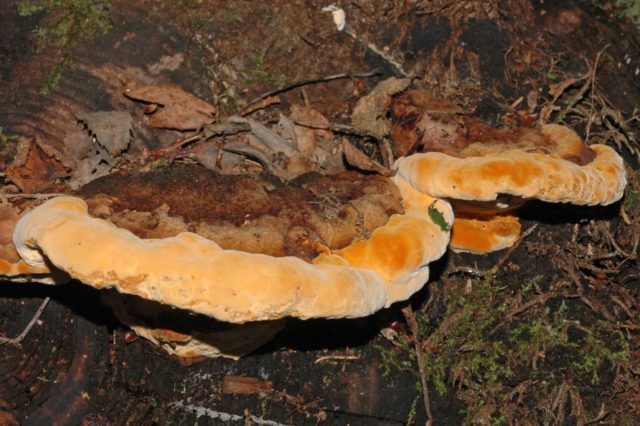
Gleophyllum odorous grows tightly to the substrate with a wide base
Where and how it grows
Gleophyllum odorous is a common species that grows everywhere. Since it is perennial, it can be seen at any time of the year. It prefers to grow on dead wood and old stumps of coniferous trees, mainly spruce. It can sometimes be seen on treated wood as well.
Main habitats:
- central part of Russia;
- Siberia;
- Ural;
- Far East;
- North America;
- Europe;
- Asia.
Doubles and their differences
Gleophyllum odorous in appearance is in many ways similar to other members of its family. But at the same time, each of them has certain differences.
- Log gleophyllum. The cap of this species is rough, its diameter does not exceed 8-10 cm. The color of the fruiting body is gray-brown, and subsequently becomes completely brown. The pulp is thin, leathery, odorless. Its shade is brownish red. It settles on stumps and fallen trees of aspen, oak, elm, less often needles. It also causes the development of gray rot like gleophyllum odorous. Refers to inedible mushrooms. The official name is Gloeophyllum trabeum.
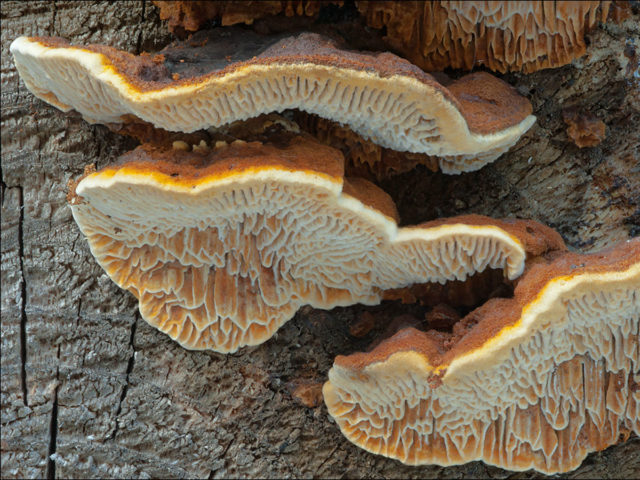
Log gleophyllum is found on all continents except Antarctica
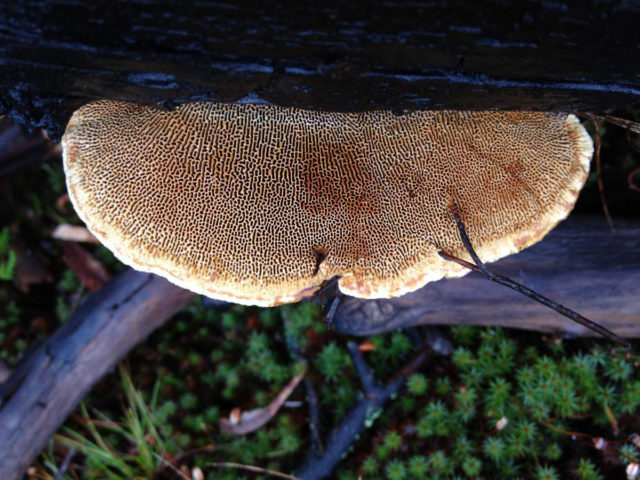
The cap of the oblong gleophyllum has the ability to bend well
Conclusion
Gleophyllum odorous is of no interest to mushroom pickers. However, its properties are carefully studied by mycologists. The position of this species has not yet been determined. Recent molecular studies have shown that the Gleophyllaceae family shares similarities with the genus Trametes.
Intake gleophyllum: photo and description
| Name: | Intake gleophyllum |
| Latin name: | Gloeophyllum sepiarium |
| Type of: | Inedible |
| Synonyms: | Agaricus sepiarius, Merulius sepiarius, Daedalea sepiaria, Lenzitina sepiaria, Lenzites sepiarius |
| Systematics: |
|
Intake gleophyllum (Gloeophyllum sepiarium) is a widespread fungus. It belongs to the Gleophilus family. There are also other names for this mushroom: Russian - tinder fungus, and Latin - Daedalea sepiaria, Lenzitina sepiaria, Agaricus sepiarius.
What does fence gleophyllum look like?
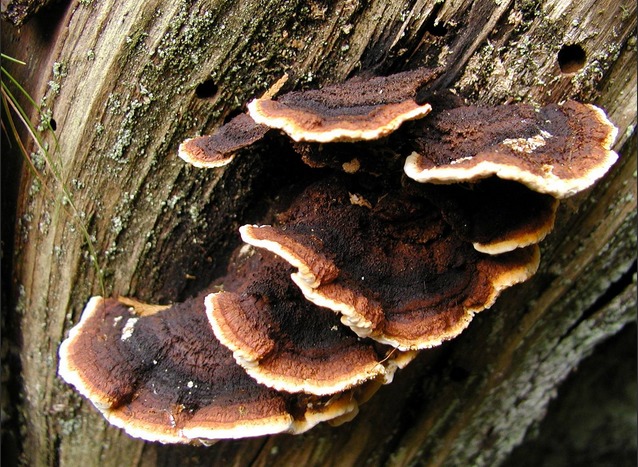
Grows on dead or damaged wood
Intake gleophyllum is found in temperate latitudes in summer and autumn, in the southern regions - all year round. Fruiting bodies are most often annuals, but under favorable conditions they can reach the age of four years.
From above, on the surface of the fungus, are noticeable: bristly pubescence, tuberous notches and irregularities, concentric zones are dark in the center and light along the edge. The main color of the fruit bodies changes with age - in young specimens it is rusty with a brown tint, in old ones it becomes brown.
Fruit bodies are rosette, half, fan-shaped, or irregular. Sometimes they are spread out, fused with each other by their lateral surfaces. Most often they grow on a substrate, one above the other in the form of shingles.
On the inner surface of a young fungus, short labyrinth tubes of the hymenophore can be seen; in mature specimens, it is lamellar, light brown or rusty. Mushroom tissues have a cork consistency, they turn black when exposed to KOH (potassium hydroxide).
Where and how it grows
Intake gleophyllum is found on the territory of Russia, as well as in other countries on all continents, except for Antarctica. It is most often found in temperate areas. The fungus belongs to saprotrophs, it destroys dead wood residues, leads to the development of brown rot. Prefers coniferous trees, occasionally grows on aspen.
You can find a mushroom by examining dead wood, dead wood, stumps in open glades in the forest. Sometimes he is found in old sheds or storage facilities built from logs. Indoor tinder fungi have an underdeveloped sterile fruiting body with coral branches and a reduced hymenophore.
Is the mushroom edible or not
No poisonous substances were found in the intake gleophyllum. However, the tough pulp does not allow it to be attributed to the edible representatives of the mushroom kingdom.
Doubles and their differences
A similar species is fir gleophyllum, a rare inedible mushroom growing in conifers. Unlike the tinder fungus, his hymenophore consists of rare, torn plates. The surface of the fruiting body is smooth, without bristles.
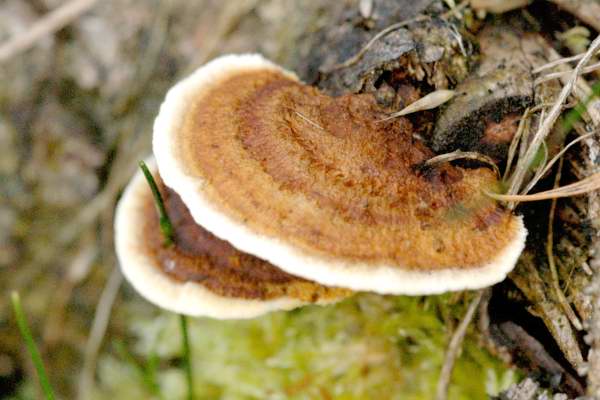
Has a rich bright color of the cap
Another double - log gleophyllum - prefers deciduous forests. It is inedible. Often found on log buildings, forming ugly outgrowths of fruit chalk. It differs from the fence tinder fungus in a grayish shade of mature specimens.
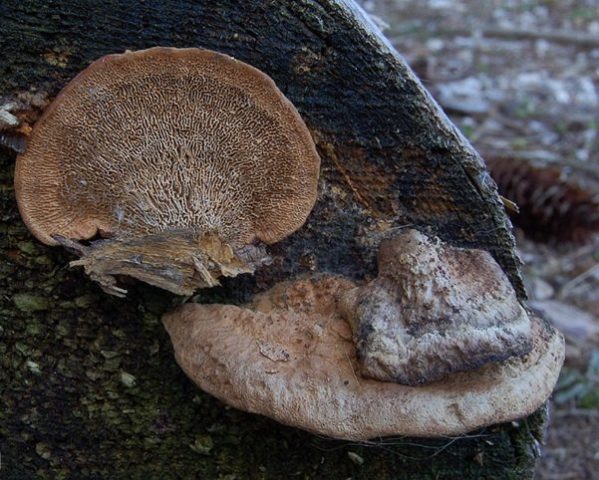
The hymenophore is characterized by the presence of pores and plates
Gleophyllum oblong grows on deadwood of both coniferous and deciduous trees. It is inedible, has a slightly elongated cap shape. The main difference from the tinder fungus is the tubular hymenophore.
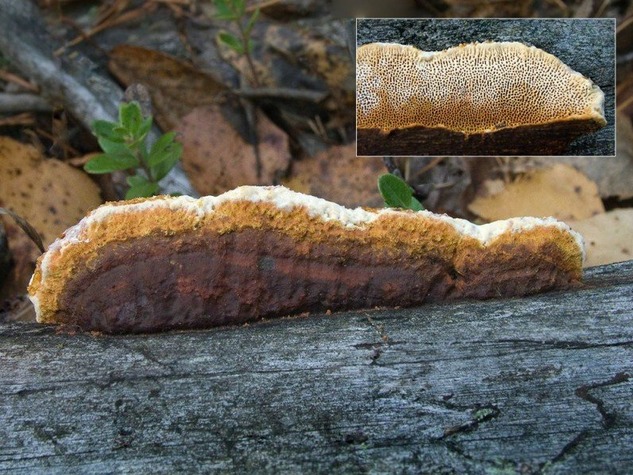
This type has a smooth and soft cap surface.
Conclusion
Intake gleophyllum settles on dead and processed wood of coniferous or deciduous species. Fruiting bodies do not contain toxic substances, but do not provide nutritional value due to the specific cork structure. Tinder fungus causes damage to wood.
Crowded row - Lyophyllum decastes
Written by Nikolay Budnik and Elena Meck.
We met the crowded row only a few times. It grows on forest edges, in meadows, fields and even on lawns in September - October.
The crowded row is called so for a reason - mushrooms grow in friendly families, growing together with the legs and sides of the hats. It is an edible mushroom that can be fried, salted, pickled. We tried the crowded Ryadovka in fried and pickled form - in our opinion, this is a mushroom of average taste.
1. The crowded row grows in large families.
2. Mushrooms usually grow together with their legs.
3. They can grow in such huge piles.
4.We found these crowded rows already in mid-October.
5. The mushrooms have survived repeated frosts. This is probably why they have such a dark color.
6. Crowded rows like open spaces.
7. Here in such a huge number they met us once.
8. Mushrooms grew among the grass.
9. And these rows have grown right on the city lawn.
10. Of course, you shouldn't collect them in the city.
11. The caps of the crowded rows are small, convex.
12. Their edges are often wavy and uneven.
13. Light colored plates.
14. They are quite rare.
15. This is how the plates are attached to the leg.
16. The legs of the mushrooms are straight, the same color with the plates.
17. Inside, they are slightly wadded, but not hollow.
18. The flesh of the mushrooms is light, a little loose.
19. Usually only hats are taken.
20. We tried pickled ryadovka, but it didn't make much of an impression.
21. But looking at her, you can once again enjoy the generosity of nature!
2017 film about crowded Ryadovka
Gleophyllum fir Gloeophyllum abietinum
Syn: Agaricus abietinus Bull., 1790 Daedalea abietina (Bull.) Fr., 1821
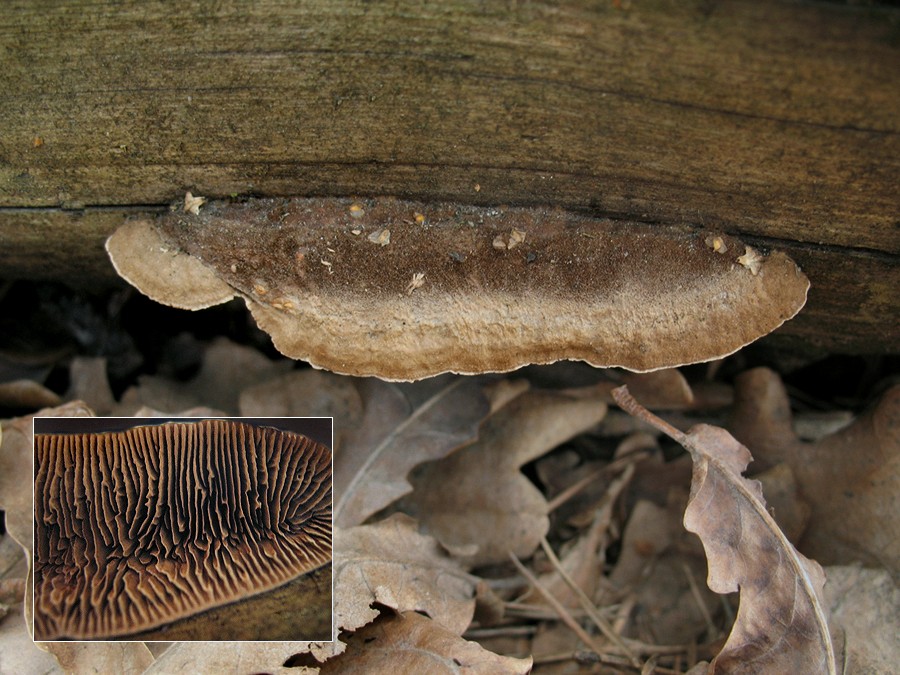
Description of the mushroom by Elena Lukashina with the participation of Vladimir Kapitonov, Sergey Lukashin, Alexey Myasnikov, Kim Potapov, Tatiana Svetlova, Andrey Smirnov
Click on the marker to get additional information about the find of this species If you still know the place of growth of this species, please determine its coordinates and send them to the site
Basic information Additional Section-3
On off. mushroom find map
| The full scientific name of this species is Gloeophyllum abietinum (Bull.) P. Karst., 1882 |
Tatyana Svetlova A tinder fungus that lives on coniferous wood is often found on spruce trees. It has medium-sized fruiting bodies with brownish-brown caps, with a hymenophore in the form of rare, uneven, thick plates. The surface of the caps is slightly grooved, rough, often with poorly visible zones and a light edge. The plates of the hymenophore are torn, dark in color, with a grayish bloom on the edges. The consistency of the mushroom is tough.
Common names
CZ: Trámovka jedlová (Czech Republic) PL: Niszczyca jodłowa (Poland) DE: Tannenblättling (Germany) FI: Heltta-aidaskääpä (Finland) FR: Gloeophylle du sapin, Lenzite du sapin (France)
Sporecap fruiting body
Fruit bodies are annual or perennial, in the form of semicircular or fan-shaped caps, 2-10 (15) cm long and 5-10 mm thick, widely accreted, sometimes semi-spread, occasionally completely spread. On the substrate, they are often arranged in tiled or in rows, growing together laterally along the dead trunks. The surface of the caps is velvety-tomentose in youth, naked in old age, with concentric furrowed zoning, sometimes with a tubercle at the base, color from tobacco or ocher-brown to umber-brown, chocolate, old fruit bodies are blackish-brown. The growing edge is lighter, thinner, even or wavy.
Hymenophore Hymenophore
The hymenophore is lamellar, from pale brown and creamy ocher to dark brown. Plates with a grayish bloom on the edges, thick, irregularly shaped, wavy, whole-edged or dentate-notched, sometimes irpexoid-torn, 4-10 mm wide, 8-11 (15) plates per 1 cm along the edge of the cap. A characteristic feature of the species is the presence of short plates located between the main ones along the edge of the cap.
Micromorphology Micromorphology
The hyphalous system is trimic. Generative hyphae are hyaline, thin-walled, septate, with buckles, up to 3-4 microns in diameter, rare. Skeletal hyphae are light brown, from thick-walled to solid, up to 5 microns in diameter, long, wavy, unbranched, unseptated. Basidia 20-28 (35) x 5-7 microns. Cystids are abundant, fusiform, thick-walled, 25-50 x 5-7 microns. The spores are initially hyaline, later pale brownish, smooth, almost cylindrical, slightly curved, obliquely sharpened at the base, 8.5-13 x 3.0-4.5 microns.
Flesh pulp
The fabric is thin (up to 1 mm thick), leathery, flexible, tobacco-brown or reddish-brown, darkening under the action of KOH.
Habitat habitat
It grows on dead wood (dry and valezhe) of conifers, more often on spruce and fir in coniferous and mixed forests, as well as in mines and basements, on processed wood (railings, posts, beams, etc.).
Distribution of Areal
Distributed throughout Russia, especially in the European part, in Siberia, in the Far East, but rarely found. General distribution: found in the temperate and subtropical zones of the Northern and Southern Hemisphere - in Europe, the Caucasus, Asia, North Africa, North America, New Zealand.
Calendar Calendar
Occurs year-round.
Edibility Edibility
Inedible.
Description of gleophyllum odorous
Fruit bodies are large enough - up to 16 centimeters in diameter. The caps can be placed singly or grow together in small groups. The shape of the cap can be very diverse - from hoof-shaped to cushion-shaped. Often the caps have nodular outgrowths.

The surface of young fruit bodies is felt, over time it coarsens, becomes uneven, rough, with a small tubercle. The color of the caps varies from red to dark. The edges are thicker, more reddish.
The flesh is approximately 3.5 centimeters thick. The structure of the pulp is cork. Its color is rusty brown, and in the KOH solution the pulp darkens. The pulp has a spicy, aniseed smell.
The thickness of the hymenophore is 1.5 centimeters. The color of the tubes is yellow-brown, becoming darker over time. The pores are rounded, angular, slightly elongated.

Places of growth of odorous gleophyllum
As a rule, this species settles on the dead trunks and stumps of conifers, choosing mainly spruce. Also, these mushrooms can settle on treated wood. This is a fairly common type.
In the Northern Hemisphere, these mushrooms are found mainly on needles. And in the tropics, they prefer to settle on rough tree species. Gleophyllum odorous causes the development of brown rot on trees.
Diseases of wood: white and brown rot
Brown or white rot? What it is and how the species differ in appearance, we will describe in more detail in the article below.
How to distinguish brown from white?
Wood-destroying fungi differ in the type of decay
There is one, but very important, difference between the two. During the "brown" lesion, first of all, light cellulose is destroyed, as a result of which a dark brown, flaky powdery lignin is formed.
A typical example is a piece of wood that has disintegrated into brownish cubes. A small test will help to find out more precisely - rub a piece of wood with your fingers (as shown in the picture below), you will have a brownish, fine dust in your hands. The situation is different with white fungus. Here, on the contrary, lignin decomposes; as a residue, we have fibrous, light or even almost white cellulose. Such wood cannot be ground into dust, it will remain fibrous.
External signs of brown rot
A typical “brownish” sign (along with cubing) is a dark brown color of the tree in the affected area. As mentioned above, this is the result of cellulosic degradation. During drying, the tree also dries out in the longitudinal direction of growth, which leads to the formation of cubes: first large, then small. At an early stage, it is quite difficult to determine the type of parasitic fungus - a barely infected tree only loses its strength over time, becoming dust.
There is a fairly large number of brown rot pathogens. From the inside, the following types can most often be found:
- Mushroom house, Serpula lacrymans
- Coniophora stinking, Coniophora puteana
- Vaillant fibroporia, Antrodia vaillantii
- White house mushroom, Antrodia sinuosa
- Oligoporus patty, Oligoporus placenta
- Antrodia, Antrodia xantha
- Chubby Pig, Paxillus panuoides
- Saw-leaf, Lentinus lepideus
- Leukogyrophana soft, Leucogyrophana mollusca
- Leukogyrophana powdery or small house mushroom, Leucogyrophana pulverulenta
On the outside of a wooden house, the following types often live:
- Oak Sponge, Daedalea quercina
- Fence mushroom, Gloeophyllum sepiarium
- Gleophyllum fir, Gloeophyllum abientinum
- Log gleophyllum, Gloeophyllum trabeum
- Serpula belt, Serpula himantioides
Brown rot can not always be seen by pathogens the first time.Below is an example of a fence mushroom that settled inside a support beam and destroyed it from the inside. At the same time, the outside of the tree retained a good, healthy look.
External signs of white rot
The end result of the "work" of white rot is the formation of a whitish-gray, soft and loose wood. The causative fungi destroy stem-forming plant cells. Unlike the brown scourge, the infected tree does not crumble into small pieces, since the fibers do not allow cuboid cracks to form.
As a rule, in residential buildings, the chance of meeting white rot is much less than brown just because the number of white pathogens is much less. Outside, it is also common. Errors often occur when determining the type of parasite. The reason for this is the double defeat. This happens when both types of rot peacefully coexist on one piece of wood.
White internal pathogens:
- White oak mushroom, Donkioporia expansa
- Star fungus, Asterostroma cervicolor
- Phlebiopsis giant, Phlebiopsis gigantea
- Fire sponge, Phellinus contiguus
- Gray polypore, Diplomitoporus lindbladii
- Domestic dung, Coprinus radians
- Bicolor resin mushroom, Resinicium bicolor
- Trichaptum fir, Trichaptum abietinum
- Scaly polypore, Polyporus squamosus
- Trametes multi-colored, Trametes versicolor
- Common nutcracker, Schizophyllum commune
- Polypore real, Fomes fomentarius
- False polypore, Phellinus igniarius
- Singed polypore, Bjerkandera adusta
Other types of tree fungus
red or fissured sound, motley honeycomb sound
A favorite habitat is coniferous wood, pathogens are pine sponge (Phellinus pini) and various types of phytophthora.
Marble is caused by real and false tinder fungi. Another special type of rot, which used to be found almost exclusively on telegraph poles - rotting, destroying cellulose in the cell membrane.
The causative agents are ascomycetes, moldy species, deuteromycetes (or imperfect fungi) and trichodermin.
False doubles
The accreted row is counted among the counterparts of the crowded row, but it is distinguished by a light color. This is a conditionally edible mushroom (in some sources it is described as poisonous). The shape of its cap varies from convex to outstretched with inverted edges. The color is whitish, often with a yellowish or ocher tinge. The pulp is dense, white with a characteristic musty odor. The leg is stiff, fibrous, and has the color of the cap. Legs often grow together in several pieces and are deformed.
Inexperienced lovers of quiet hunting often confuse the crowded row with other types of mushrooms, conditionally edible lyophillums - armored (Lyophyllum loricatum) and smoky gray (Lyophyllum fumosum). The photo clearly illustrates the differences between these species and how each of the twins might look.
Log gleophyllum: photo and description
| Name: | Log gleophyllum |
| Latin name: | Gloeophyllum trabeum |
| Type of: | Inedible |
| Specifications: | |
| Systematics: |
|
Log gleophyllum is an inedible fungus that infects wood. It belongs to the class Agaricomycetes and the Gleophilus family. The parasite is most often found on coniferous and deciduous trees. Its features include growth throughout the year. The Latin name for the fungus is Gloeophyllum trabeum.
What does log gleophyllum look like?
Log gleophyllum is distinguished by a narrow oblong cap, up to 10 cm in size. Adult specimens have a rough surface covered with bristles. The cap of young mushrooms is pubescent. The hymenophore is mixed, and the pores are small enough, with thin walls.
The color ranges from brown to grayish. The pulp has a leathery structure and a reddish tinge, the spores are cylindrical.
Most often, fruits grow in groups, but sometimes they are found in a single copy.
Where and how it grows
Log gleophyllum grows almost everywhere except Antarctica. It is found not only in wildlife, but also on the surface of wooden houses. At the place of accumulation of fruit bodies, brown rot is formed, which further leads to the destruction of the tree. In Russia, they most often live in deciduous forests. The log species began to be called precisely because of the places of distribution. In France, the Netherlands, Latvia and Great Britain, it is listed in the Red Book.
Doubles and their differences
In appearance, log gleophyllum is often confused with its counterparts. But experienced mushroom pickers can easily distinguish one species from another. After all, each of them has characteristic features.
Gleophyllum odorous
The double's hat can reach a diameter of 16 cm. It has a cushion or hoof shape. The surface of the hat is covered with growths. The degree of roughness is determined by the age of the fruiting body. The color is ocher or cream. Cork pulp texture. The double got its name due to its characteristic aniseed aroma. It intensifies when the pulp is broken. Odorous gleophyllum is classified as an inedible mushroom.
Instances living in the tropics settle on coarse woods
Gleophyllum oblong
The oblong gleophyllum most often inhabits stumps and dead woods, but sometimes it also occurs on deciduous trees. He loves well-lit places, so he can be found in clearings, conflagrations and near human habitation. The double's cap has a triangular shape, reaching 12 cm in diameter. The fruit body is distinguished by a leathery elastic structure.
In adult specimens, cracks may be present on the surface of the hat. The color ranges from yellow to off-gray. In some cases, a metallic sheen is present. A distinctive feature is wavy edges, which may be slightly darker in color than the cap. A representative of this species is inedible, which is why it is strictly forbidden to eat.
The twin can hit fast-moving tree trunks
Dedaliopsis tuberous
Dedaliopsis tuberous (tinder fungus tuberous) differs from the log predecessor in the variety of hymenophores and in the appearance of the hat. Its diameter can reach 20 cm. A distinctive feature is a dry and bumpy surface covered with wrinkles. They divide the mushroom into color zones. The border of the hat has a gray tint. The pores with their pattern resemble a maze. Belongs to the group of inedible species.
Dedaliopsis tuberous is in demand in pharmacology
Conclusion
Log gleophyllum can grow for 2-3 years. He covers diseased trees, contributing to their complete destruction. As they grow older, the appearance of the fruiting body may change.

